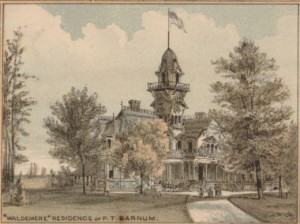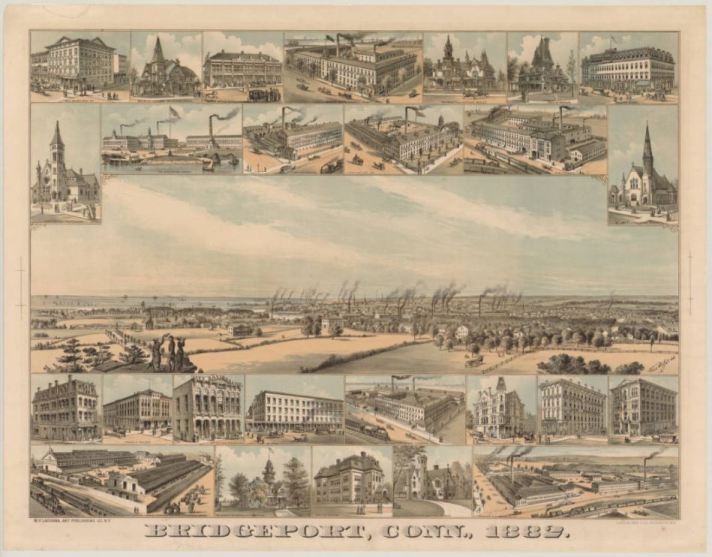By Kate Steinway
In the late 1800s, panoramic illustrations, known as bird’s-eye views, became a popular means of portraying towns throughout Connecticut as the industrial age transformed them from agrarian hamlets into booming economic centers. Bird’s-eye view lithographs earned their name because the city or town depicted was rendered as though seen from a high vantage point.

Detail of smokestacks from Bridgeport, Conn., 1882, tinted lithograph, Wils Porter, artist, Charles Hart, New York, lithographer, New York: W.O. Laughna, 1882 – Connecticut Historical Society
This 1882 example is somewhat atypical in that Bridgeport is not shown from the lofty aerial angle of most of the bird’s-eye views of the 1880s. Instead, merging the tradition of landscape prints with bird’s-eye views, the lithograph is drawn from an elevated position outside of the city. Thirty-six smokestacks belching dark smoke are visible above the indistinguishable buildings and trees. This creates a contemporary image of urban prosperity and activity. In the foreground, a group of people enjoy an excursion outside the crowded city.

Detail of Waldemere from Bridgeport, Conn., tinted lithograph, Wils Porter, artist, Charles Hart, New York, lithographer, New York: W.O. Laughna, 1882 – Connecticut Historical Society
The vignettes across the top and bottom of the view depict many of the businesses, churches, schools, residences, and industries of Bridgeport and dominate the proportionately smaller view. Best known for women’s apparel, sewing machines, and seamless brass tubing, the industries were almost as celebrated as Bridgeport’s most famous resident, Phineas T. Barnum, whose circus and other show business ventures were world renowned. Barnum served as mayor of Bridgeport in 1875 and was an active civic leader. Waldemere (vignette) was the third of his four residences built in the city, and the flag waving from the rooftop was flown only when Barnum was at home.
Kate Steinway, formerly the Executive Director of the Connecticut Historical Society (CHS) in Hartford, curated the traveling exhibition, Hamlets & Hubs; Bird’s-Eye Views of Connecticut Towns, 1849-1908 (1987-88), from which this article is derived, while Curator of Prints and Photographs at CHS.









